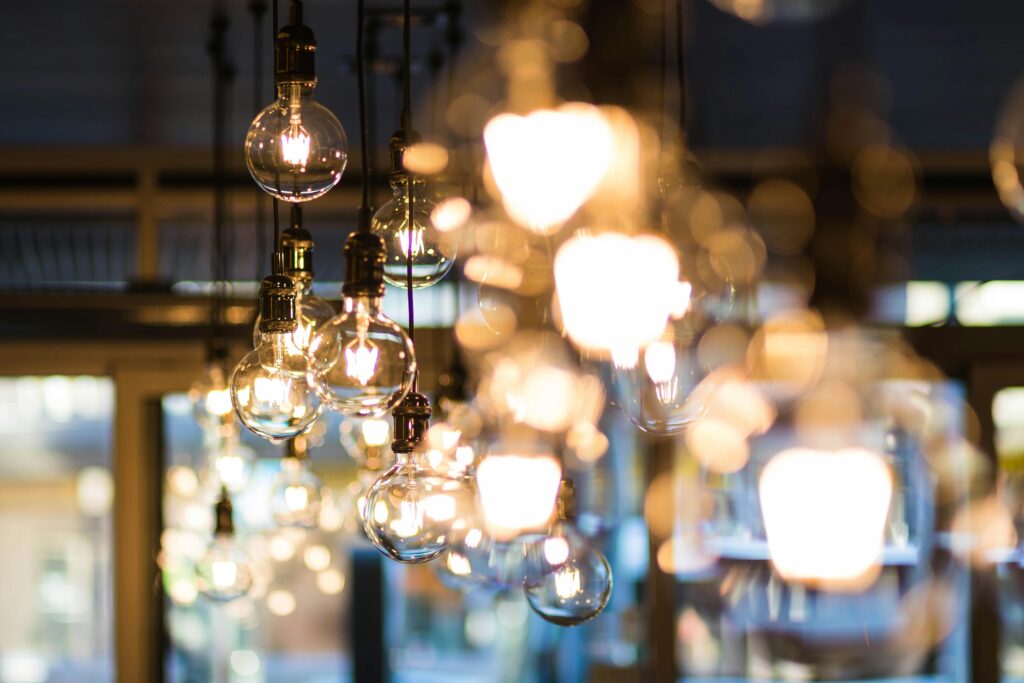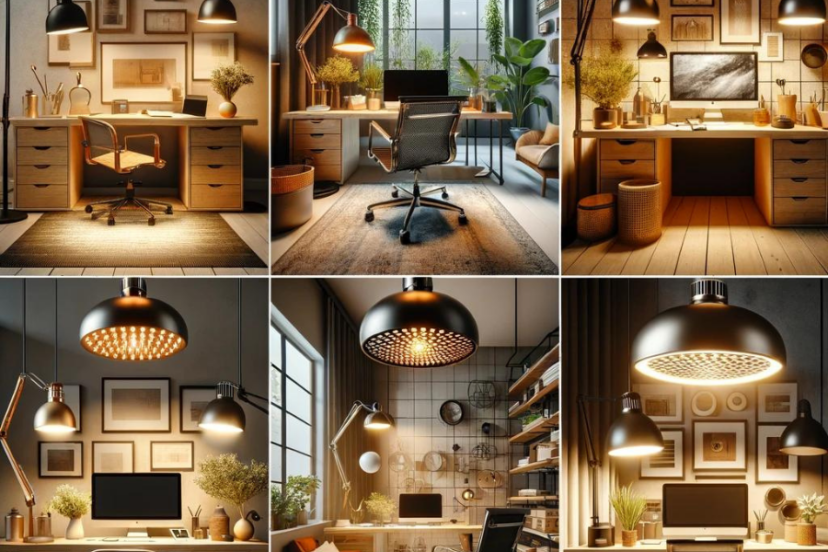Home Office Lighting: Guide to Illuminating Your Workspace
Introduction
What’s the point of working at home if you can’t enjoy the space where you are working? One of the game-changers in making my home office not just functional but a place I genuinely enjoy working in was getting the lighting right. You see, lighting does more than just brighten a room; it sets the mood, influences energy levels, and significantly impacts productivity.

The Impact of Lighting on Productivity and Mood
Did you know that poor lighting can lead to eye strain, fatigue, and even affect your mood? Yep, that’s right. The right lighting, however, can do wonders. It can keep you focused, uplift your spirits, and even boost creativity. That’s why paying attention to your home office lighting isn’t just about décor; it’s about enhancing your work life.
Understanding the Basics of Home Office Lighting
Illuminating your home office might seem daunting at first, but don’t worry—I’ve got you covered. We’ll explore everything from the types of lighting you need to the best bulbs for your eyes and productivity. Plus, I’ll share some product recommendations and handy tips to help you create the perfect lighting setup.
So, grab a drink, and let’s shed some light on how to brighten up your workspace effectively. Trust me, your future self (and your eyes) will thank you.
Types of Lighting Every Home Office Needs
Lighting can be classified into three main types: ambient, task, and accent. Each plays a unique role in creating an efficient and comfortable home office environment.
Ambient Lighting: Setting the Base
Ambient lighting, also known as general lighting, is the foundation of your home office lighting plan. It provides the overall illumination of your space, allowing you to move around safely and see clearly. Think of it as the natural light of your room, but provided by fixtures like ceiling lamps, recessed lighting, or floor lamps. For my home office, I found that a combination of a central ceiling fixture with a couple of strategically placed floor lamps created a well-balanced light environment that reduced shadows and glare.
Task Lighting: Focusing Where It Matters
Next up, task lighting. This type is crucial for reducing eye strain and increasing productivity. Task lighting focuses light where you need it most, like on your desk or reading area. Desk lamps with adjustable arms are perfect for this. They allow you to direct light exactly where you need it, minimizing reflections and glare on your computer screen. I personally love an LED desk lamp with a dimmer; it lets me adjust the brightness based on the time of day and the task at hand.
Accent Lighting: Adding Depth and Interest
While accent lighting may seem more decorative, it plays an important role in elevating the aesthetic of your home office and can even enhance functionality. By highlighting specific areas or objects, accent lighting adds depth and character to your space. Use it to spotlight artwork, bookcases, or shelving units. Not only does this create a more dynamic and visually interesting office, but it also offers the flexibility to spotlight areas for functionality or decoration.
Each type of lighting contributes to creating a well-lit, productive, and comfortable home office space. It’s about balancing functionality with personal style to create a workspace that inspires and motivates you.

Choosing the Right Bulbs
The bulbs you choose for your home office can significantly impact your productivity, mood, and even your energy bill. Let’s break down the options and what you need to consider.
LED vs. Incandescent vs. Fluorescent
When it comes to home office lighting, LED bulbs are my go-to choice. They’re energy-efficient, have a longer lifespan, and offer a range of color temperatures. Incandescent bulbs, while cheaper upfront, have a shorter lifespan and use more energy. Fluorescent bulbs, on the other hand, are a middle ground in terms of energy efficiency and lifespan but can sometimes cast a harsh light and contain mercury.
Color Temperature and Why It Matters
Color temperature is measured in Kelvins (K) and describes how warm (yellow) or cool (blue) the light appears. For home offices, a color temperature between 4000K to 5000K is often recommended because it’s close to daylight, which can enhance focus and energy levels. I found that bulbs around 4500K strike a nice balance, providing a bright, neutral light that’s not too harsh or too warm.
Choosing the right bulbs is about more than just fitting a lamp; it’s about crafting an environment that encourages focus and wellbeing. LED bulbs with a suitable color temperature can transform your space, making it a place where you’re happy to work.
Innovative Lighting Solutions for Home Offices
In the age of smart homes, your office lighting can do much more than just turn on and off. Let’s explore some options that blend technology with functionality.
Smart Lights: Control at Your Fingertips
Smart lighting systems have revolutionized home office environments. Imagine adjusting brightness, color temperature, and even turning lights on or off with just a voice command or a tap on your smartphone. Brands like Philips Hue and LIFX offer LED smart bulbs that can be programmed to change settings throughout the day automatically, mimicking natural sunlight patterns to help maintain your circadian rhythm and keep your energy levels steady. I’ve personally experienced a boost in my productivity and mood since integrating smart lights into my workspace.
Natural Light: Making the Most of Your Environment
While not a ‘solution’ you can buy, optimizing natural light is crucial. Position your desk near a window if possible, but avoid direct sunlight that can cause glare. Use sheer curtains to diffuse harsh light, maintaining a well-lit room without the downsides. For those gloomy days or working late, combine your natural light with the artificial light sources we’ve discussed to keep your space inviting and productive.
Innovative lighting solutions offer the flexibility to create a dynamic home office environment that adapts to your needs, ensuring you’re always working in the best light possible.
Lighting Tips for Video Conferences
In our digital age, video conferences are a routine part of our days. Here’s how to light your space to look your best on camera.
Positioning Your Lighting for Clarity
Avoid backlighting from windows or lamps that can make you appear silhouetted. Instead, aim for soft, diffused lighting in front of you to illuminate your face evenly. A ring light placed behind your webcam or a well-positioned desk lamp can make a significant difference in how professional you look on video calls.
Avoiding Common Lighting Mistakes
Steer clear of overhead lighting as your primary source during calls, as it can create harsh shadows. Similarly, too much light can wash you out. Experiment with your setup to find a balance that works best for your space and skin tone, ensuring you’re seen clearly and without distraction.
Good lighting for video conferences doesn’t just show your face clearly; it also signals professionalism and attention to detail—qualities essential in any line of work.
Product Recommendations
When it comes to setting up the ideal lighting, the right products can make all the difference. Here are my top picks across ambient, task, and accent lighting, designed to enhance any home office.
Best Ambient Light Options
- Philips Hue White Ambiance: This smart LED bulb kit allows you to adjust color temperature and brightness, perfect for creating the right ambient light in your office. It’s compatible with Alexa, Google Assistant, and Apple HomeKit for easy control.
- Taotronics LED Floor Lamp: Sleek and modern, this lamp offers adjustable brightness and color temperature, providing a soft, widespread light that can fill your room without overwhelming it.
Top Task Lights for Efficiency
- BenQ e-Reading LED Desk Lamp: Specifically designed to reduce eye strain during reading and computer work, this lamp has an auto-dimming feature and adjusts its brightness according to the room’s ambient light.
- Lume Cube Video Conference Lighting Kit: For those countless video calls, this small but powerful light clips to your laptop or monitor, offering adjustable brightness and color temperature to make you look your best.
Accent Lights to Enhance Your Space
- Govee Lyra Floor Lamp: This RGBIC floor lamp can display multiple colors at once and can be controlled via an app, adding both functionality and a pop of color to your office.
- Nanoleaf Shapes: For a more avant-garde approach, these modular light panels can be arranged in any pattern, offering endless possibilities to add a personal touch to your workspace.
Choosing the right lighting products is not just about functionality; it’s about creating a space that inspires you to do your best work. Whether it’s the practicality of a task lamp or the ambiance set by smart bulbs, the right lighting setup can transform your home office into a productivity haven.
Conclusion
Lighting your home office is about more than just making sure you can see your keyboard. It’s about creating an environment that fosters productivity, enhances mood, and supports your wellbeing. By understanding the types of lighting and choosing the right bulbs and innovative solutions, you can create a workspace that not only meets your functional needs but also reflects your personal style and ambition.
Remember, the best lighting setup is one that adapts to your needs, changing as your day progresses and as tasks shift. With the right approach and products, you can create a home office that illuminates your path to success.
FAQ Section
- How much natural light is ideal for a home office?
- Aim for a balanced amount that brightens your space without causing glare. Use window treatments to diffuse direct sunlight as needed.
- Can the right lighting really improve productivity?
- Absolutely. Proper lighting reduces eye strain and fatigue, which can enhance focus and efficiency.
- What’s the best color temperature for a home office?
- A range between 4000K to 5000K is generally recommended, as it closely mimics daylight and supports concentration and alertness.
- How can I set up lighting for my home office on a budget?
- Start with what you have—maximize natural light and supplement with affordable task lighting. LED bulbs are a cost-effective choice due to their energy efficiency and long life.
- Are smart lights worth the investment for home offices?
- For those who value flexibility and control over their environment, smart lights are a worthwhile investment, offering features like scheduling, remote control, and customization that can enhance your work-from-home experience.
This comprehensive guide aims to shine a light on the importance of proper lighting in your home office, helping you create a space that not only looks great but also boosts your productivity and wellbeing.





